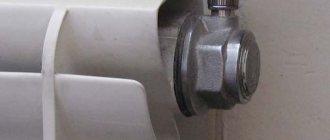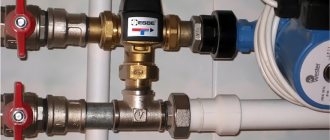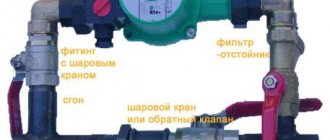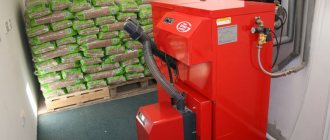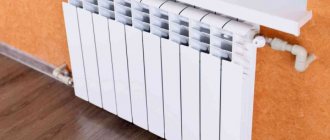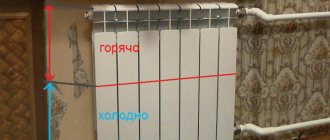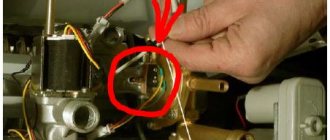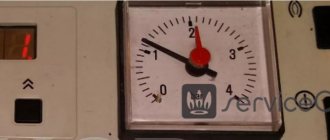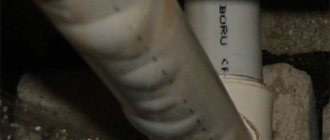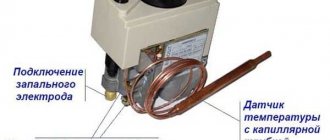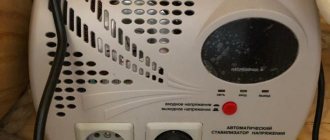Using the Safety Valve
This is not the same thing as a safety valve. The latter simply relieves pressure in the system, but does not cool it. Another thing is the boiler overheating protection valve, which takes hot water from the system and instead supplies cold water from the water supply. The device is non-volatile and is connected to the supply and return lines, water supply network and sewerage system.
When the coolant temperature is above 105 ºС, the valve opens and, thanks to a pressure in the water supply of 2-5 Bar, hot water is forced out of the heat generator jacket and pipelines with cold water, after which it goes into the sewer. How the solid fuel boiler protection valve is connected is shown in the diagram:
The disadvantage of this method of protection is that it is not suitable for systems filled with antifreeze liquid. In addition, the scheme is not applicable in conditions where there is no centralized water supply, because along with a power outage, the supply of water from a well or pool will also stop.
Chimney requirements
To determine what characteristics the manufacturer himself presents, you need to read the instructions, because specific data is given there, what is the minimum cross-section of the pipe needed, height, temperature conditions - these factors in a particular case are fundamental and you need to focus on them. As a rule, the instructions contain the manufacturer writes which chimney is better for a solid fuel boiler and what technical parameters need to be taken into account. The above listed characteristics, such as the height and length of the chimney, will allow you to choose a reliable and, most importantly, functional channel from the point of view of this particular model.
Consider the diameter of the chimney for a solid fuel channel, because not every channel will be able to remove the formed amount of gas in a certain time, and accumulated fumes and gases can enter the room through unsealed joints and cracks.
Technological requirements
The following technical requirements must be observed:
- A special area must be provided to disperse the smoke. It is a vertical pipe installed behind the nozzle of a solid fuel boiler. The acceleration section is made one meter high.
- The chimney is installed only vertically. Deviation of no more than 30 degrees is allowed.
- Deflections are prohibited.
- The length is very important (3 - 6 meters).
- Three horizontal sections are allowed. Moreover, the length of each should not exceed half a meter.
- The height of the head above the roof must exceed 100 cm.
- The pipe is attached to the wall in 1.5 meter increments.
- To create a sealed joint, the pipes are generously lubricated with heat-resistant sealant.
To obtain ideal draft, it is necessary that the chimney design has a minimum number of turns. A straight pipe is considered best.
The chimney can be installed inside or outside the building. For the first option, it is necessary to protect the pipe so that it does not come into contact with flammable materials. A special metal screen is used, installed where the pipe passes through the ceiling. The chimney must be located at a distance of more than 25 cm from the wall.
External structures look much safer. They are much easier to maintain. Masters consider this method the most preferable.
Causes of overheating
The only reason for overheating is that the boiler produces more heat than is consumed by the heating system. But if everything was fine before, and now the boiler is overheating, then the problem is not that the boiler is very powerful, but the problem is something else.
It is possible that you simply have a clogged dirt filter in front of the circulation pump. In this case, you need to unscrew it and clean it and the problem will be solved. If you have this problem, your return will be cold.
There is an option that the circulation pump is simply broken. If you have this problem, your return will also be cold. Change the pump.
But the most common problem is overheating as a result of a power outage. Everything is perfect for you - a clean filter, a working pump, but it just can’t work. And overheating occurs. You can solve the problem by extinguishing the boiler or pulling out the burning fuel from the boiler firebox - but this is far from the best option. The best option is to make the heating system insensitive to power outages - make it gravity-fed or install an uninterruptible power supply.
Watch a video showing how the boiler overheats when the power supply is turned off.
And here is a video with a method for solving the problem of overheating of the boiler and heating system.
A true boiler repair specialist is hard to find.
Therefore, it is important to understand them yourself, because a specialist is really not always required and many problems can be eliminated yourself. Let's look at the list of boiler faults, which maximally covers all possible breakdowns
The article is intended for a non-specialist, but an ordinary person who can eliminate such problems.
Why is the riser hot and the batteries cold?
Sometimes, with a hot supply, the return of the heating battery still remains cold. There are several main reasons for this:
- installation was performed incorrectly;
- the system or one of the risers of a separate radiator is airborne;
- insufficient fluid flow;
- the cross-section of the pipe through which the coolant is supplied has decreased;
- The heating circuit is dirty.
Cold return is a serious problem that must be eliminated. It entails many unpleasant consequences: the temperature in the room does not reach the desired level, the efficiency of radiators decreases, and there is no way to correct the situation with additional devices. As a result, the heating system does not work as it should.
The main trouble with cold return is the large temperature difference that occurs between the supply and return temperatures. In this case, condensation appears on the walls of the boiler, reacting with carbon dioxide, which is released during fuel combustion. As a result, acid is formed, which corrodes the walls of the boiler and shortens its service life.
Circuit with heat accumulator
A number of European Union countries have introduced rules according to which schemes for connecting solid fuel boilers to the heating system must necessarily include a heat accumulator. Without it, the operation of such heaters is simply prohibited. The reason is the high content of carbon monoxide (CO) in emissions while limiting the supply of oxygen to the firebox to reduce the intensity of combustion.
With normal air access, harmless carbon dioxide (CO2) is formed, so the firebox must operate at full capacity, transferring energy to the heat accumulator. Then the CO content will not exceed environmental standards. In the post-Soviet space there are no such requirements yet; accordingly, we continue to block the air supply in order to achieve slow smoldering of wood, for example, in a long-burning boiler.
Heat accumulators are commercially available as a finished product, although many craftsmen make them themselves. By and large, this is a tank covered with a layer of thermal insulation. The factory version may have a built-in DHW circuit and heating element for heating water. This solution allows you to accumulate heat from a wood-burning boiler, and when it is idle, provide heating for the house for some time. The connection diagram of the boiler with the heat accumulator is shown in the figure:
Note. In the circuit, instead of a mixing unit consisting of several elements, a ready-made device is installed that performs the same functions - LADDOMAT 21.
Why does a solid fuel boiler boil and explode?
There is only one reason - the large inertia of the boiler. If there is a sudden stop in heat extraction, the boiler cannot go out quickly. The coolant in the boiler boils, and the increased pressure ruptures the boiler.
Modern heating systems are energy dependent. They have a circulation pump installed, or even several pumps.
The circulation pump circulates the coolant in the heating system and boiler. If circulation stops, the solid fuel boiler will boil.
For this reason, many people like gravity or gravity heating systems. It does not contain elements that require electricity. This is the only advantage of a gravity system. I can’t even imagine what needs to be done to make the boiler boil with such a heating system.
What are the ways to protect heating equipment from overheating?
In order to increase the consumer attractiveness of their products, manufacturing companies try to include any guarantees of their safety in the technical passport of boiler equipment. The uninitiated consumer has no idea about the means of protecting a heating boiler from boiling.
The following methods currently exist to ensure the protection of solid fuel units used for autonomous heating systems. The effectiveness of each method is explained by the operating conditions of boiler equipment and the design features of the units.
In most cases, in the technical data sheet for a heating device, manufacturers recommend using tap water for cooling. In some cases, solid fuel heating boilers are equipped with built-in additional heat exchangers. There are models of boilers with remote heat exchangers. A safety valve is used to prevent overheating. The safety valve is designed only to relieve excessive pressure in the system, while the safety valve allows access to tap water when the boiler overheats.
Exceeding the temperature of the coolant above 100 0C creates excess pressure that opens the valve. Under the influence of tap water, which is supplied under pressure of 2-5 bar, hot water is forced out of the circuit by cold.
The first aspect that causes controversy about cooling with tap water is the lack of electricity to operate the pump. The expansion tank does not contain enough water to cool the boiler.
The second aspect that this cooling method rejects is related to the use of antifreeze as a coolant. If an emergency occurs, up to 150 liters of antifreeze will go into the sewer along with the incoming cold water. Is this method of protection worth it?
The presence of a UPS will allow you to maintain the operation of the circulating pump in a critical situation, with the help of which the coolant will evenly disperse through the pipeline without having time to overheat. As long as the battery capacity lasts, the uninterruptible power supply guarantees the operation of the pump. During this time, the boiler should not have time to heat up to critical parameters; the automation will work, running water through a spare, emergency circuit.
Another way to get out of a critical situation would be to install an emergency circuit in the piping of a solid fuel unit. Switching off the pump can be duplicated by the operation of a spare circuit with natural coolant circulation. The role of the emergency circuit is not to provide heating for residential premises, but only to be able to remove excess thermal energy in an emergency.
This scheme for organizing the protection of the heating unit from overheating is reliable, simple and easy to use. You will not need any special funds for its equipment and installation. The only conditions for such protection to work are:
- the presence of an expansion tank or storage tank in the system;
- use of a petal type check valve only;
- the secondary circuit pipes must be larger in diameter than the conventional heating circuit.
Heating system design - what is return?
The heating system consists of an expansion tank, batteries, and a heating boiler. All components are connected to each other in a circuit. A coolant liquid is poured into the system. The liquid used is water or antifreeze. If the installation is done correctly, the liquid is heated in the boiler and begins to rise through the pipes. When heated, the liquid increases in volume, the excess enters the expansion tank.
Since the heating system is completely filled with liquid, the hot coolant displaces the cold coolant, which returns to the boiler, where it is heated. Gradually, the temperature of the coolant increases to the required temperature, heating the radiators. Liquid circulation can be natural, called gravitational, or forced, using a pump.
The return is a coolant that, having passed through all the heating devices included in the circuit, gives up its heat and, cooled, enters the boiler again for the next heating.
Batteries can be connected in three ways:
- 1. Bottom connection.
- 2. Diagonal connection.
- 3. Lateral connection.
In the first method, the coolant is supplied and the return is discharged at the bottom of the battery. This method is advisable to use when the pipeline is located under the floor or baseboards. With a diagonal connection, the coolant is supplied from above, the return is discharged from the opposite side from below. This connection is best used for batteries with a large number of sections. The most popular method is side connection. The hot liquid is connected from above, the return is discharged from the bottom of the radiator on the same side where the coolant is supplied.
Heating systems differ in the way pipes are laid. They can be laid in one-pipe or two-pipe ways. The most popular is the single-pipe wiring diagram. Most often it is installed in multi-storey buildings. It has the following advantages:
- a small number of pipes;
- low cost;
- ease of installation;
- serial connection of radiators does not require the organization of a separate riser for liquid drainage.
Disadvantages include the inability to adjust the intensity and heating for a separate radiator, and a decrease in the temperature of the coolant as it moves away from the heating boiler. To increase the efficiency of single-pipe distribution, circular pumps are installed.
To organize individual heating, a two-pipe pipe layout is used. Hot feed is carried out through one pipe. In the second, cooled water or antifreeze flows back into the boiler. This scheme makes it possible to connect radiators in parallel, ensuring uniform heating of all devices. In addition, the two-pipe circuit allows you to regulate the heating temperature of each heating device separately. The disadvantage is the complexity of installation and the high consumption of materials.
How does a thermostatic distribution valve work?
The thermostatic valve is installed on the supply in front of the bypass section (pipeline section) connecting the supply and return of the boiler in close proximity to the boiler. This creates a small coolant circulation circuit. The thermoflask, as mentioned above, is installed on the return pipeline in close proximity to the boiler.
At the moment of boiler startup, the coolant has a minimum temperature, the working fluid in the thermoflask occupies a minimum volume, there is no pressure on the thermohead rod, and the valve allows the coolant to flow only in one direction of circulation in a small circle.
As the coolant heats up, the volume of the working fluid in the thermoflask increases, the thermal head begins to put pressure on the valve stem, passing the cold coolant to the boiler, and the heated coolant into the general circulation circuit.
As a result of mixing cold water, the temperature in the return line decreases, and, therefore, the volume of the working fluid in the thermal flask decreases, which leads to a decrease in the pressure of the thermal head on the valve stem. This in turn leads to the cessation of the supply of cold water to the small circulation circuit.
The process continues until the entire coolant is heated to the required temperature. After which the valve blocks the movement of the coolant through the small circulation circuit, and the entire coolant begins to move through the large heating circle.
The thermostatic mixing valve works in the same way as a distribution valve, but it is installed not on the supply pipe, but on the return pipe. The valve is located in front of the bypass, connecting the supply and return and forming a small circle of coolant circulation. The thermostatic flask is mounted in the same place - on a section of the return pipeline in close proximity to the heating boiler.
While the coolant is cold, the valve allows it to flow only in a small circle. As the coolant heats up, the thermal head begins to put pressure on the valve stem, allowing part of the heated coolant to pass into the general circulation circuit of the boiler.
As you can see, the scheme is extremely simple, but at the same time effective and reliable.
The thermostatic valve and thermal head do not require electrical energy to operate; both devices are non-volatile. No additional devices or controllers are needed either. To heat the coolant circulating in a small circle, 15 minutes are enough, while heating the entire coolant in the boiler can take several hours.
This means that using a thermostatic valve, the duration of condensation formation in a solid fuel boiler is reduced several times, and along with it, the time of the destructive effects of acids on the boiler is reduced.
To protect a solid fuel boiler from condensation, it is necessary to properly piping it, using a thermostatic valve and creating a small coolant circulation circuit.
When purchasing and installing a solid fuel boiler, it is necessary to take into account the peculiarities of its operation, namely the high probability of overheating in emergency situations, which can result in a serious accident and even destruction of the water jacket of the unit (explosion). Also, considerable harm can be caused by the formation of condensation on the walls of the combustion chamber, which happens under certain operating conditions. To eliminate such troubles, the solid fuel boiler must be protected from overheating and condensation, which will be discussed in our article.
About three way valve
The device comes in two types:
- distribution;
- mixing
The first is installed on the supply pipeline, the second on the return pipeline. The valve's job is to regulate not only temperature, but also fluid flow. The device never closes or opens it completely. The valve itself is closed only when the boiler is started.
The mixing and distribution valves are non-volatile. They do not require additional devices or controllers. Heating of the coolant on a small circle is completed in 15-20 minutes. Sometimes an hour is not enough to warm up the water in the entire system.
The cost of a thermostatic valve is from 5 to 7 thousand rubles. Even taking into account installation costs, this is more profitable than buying a mixing unit. Moreover, the valve provides the same effective removal of condensate.
The occurrence of condensation or overheating can be minimized at the system design stage. This applies, for example, when choosing pipes from a certain material.
Polymer products are more susceptible to high heat. It is better to wire the heater with copper or steel, and attach polypropylene elements to the distribution manifold. The presence of a metal pipe in the “return” section between the three-way valve and the boiler pipe is of particular importance - the temperature sensor on the polymer will react to overheating with a delay.
Basic wiring diagram for a solid fuel boiler
For a better understanding of the processes that occur during operation of the heat generator, we will show its wiring in the figure, and then analyze the purpose of each element. In the case when the heating unit is the only heat source in the house, it is recommended to use the following basic diagram to connect it:
Note. The basic diagram, where there is a small boiler circuit and a three-way valve, shown in the figure, is mandatory for use when working together with other types of heat generators.
So, the first thing on the path of coolant movement from the boiler installation is the safety group. It consists of three parts installed on one manifold:
- pressure gauge - to control the pressure in the network;
- automatic air release valve;
- safety valve.
When operating a solid fuel boiler, there is always a risk of overheating of the coolant, especially at modes close to maximum power. This is due to a certain inertia of fuel combustion, because when the required water temperature is reached or there is a sudden power outage, it will not be possible to immediately stop the process. Within a few minutes after the air supply is stopped, the coolant will still heat up, at which point the risk of steam formation arises. This leads to an increase in pressure in the network and the danger of destruction of the boiler or burst pipes.
To avoid emergency situations, the piping of a solid fuel boiler must include a safety valve. It is adjusted to a certain critical pressure, whose value is indicated in the heat generator’s passport. As a rule, the value of this pressure in most systems is 3 Bar; when it is reached, the valve opens, releasing steam and excess water.
Further, in accordance with the diagram, for proper operation of the unit it is necessary to organize a small coolant circulation circuit. Its task is to prevent cold water from the home heating system from entering the heat exchanger and water jacket of the boiler. This is possible in 2 cases:
- when starting heating;
- When the pump stops due to a power outage, the water in the pipelines cools down, and then the voltage supply is restored.
Important! A power outage situation poses a particular danger to cast iron heat exchangers. A sudden pump supply of cold water from the system can lead to its cracking and loss of tightness.
If the firebox and heat exchanger are made of steel, then connecting the solid fuel boiler to the heating system through a three-way valve protects them from low-temperature corrosion. The phenomenon occurs when condensation forms on the inner walls of the combustion chamber due to temperature differences. Mixing with volatile fractions and ash, moisture forms a layer of scale on steel walls, which is very difficult to clean off. In this case, the metal is subject to corrosion and the service life of the product as a whole is reduced.
The scheme works on the following principle: while the water in the boiler jacket and in the system is cold, the three-way valve allows it to circulate through a small circuit. After reaching a temperature of 60 ºС, the unit begins to mix coolant from the network at the inlet of the unit, gradually increasing its flow rate. Thus, all the water in the pipes warms up gradually and evenly.
How to get rid of condensation in the boiler firebox?
In solid fuel boilers, moisture may form on the inner walls of the combustion chamber. This happens when the firewood has already flared up and the boost fan (if there is one) is working at full strength, but the water in the heating system is still cold.
The temperature difference causes condensation to form, which, mixing with combustion products, settles on the walls of the chamber. This deposit causes corrosion of the metal, as a result of which the service life of the boiler is significantly reduced.
Note. Boilers with a cast iron heat exchanger are not afraid of corrosion, but, in turn, are sensitive to sudden changes in coolant temperature.
Solving this problem is not difficult, you just need to include a three-way thermostatic valve in the piping circuit, set to a coolant temperature of 55-60 ºС, as shown in the figure below. The protection of a solid fuel boiler from condensate operates as follows: until the water in the boiler heats up to the set temperature, it circulates through a small circuit. After sufficient heating, the three-way valve gradually mixes in water from the system. Thus, there is no temperature difference or condensation in the firebox.
The introduction of a mixing unit into the circuit also protects the cast-iron heat exchanger from changes in coolant temperatures, since the valve will not allow cold water to enter the heat generator.
The basic principle of protecting the boiler from condensation
To protect a solid fuel boiler from the formation of condensation, it is necessary to eliminate the situation in which this process is possible. To do this, do not allow cold coolant to enter the boiler. The return temperature should be 20 degrees less than the supply temperature. In this case, the supply temperature must be at least 60 C.
The simplest method is to heat a small amount of coolant in the boiler to the nominal temperature, create a small heating circuit for its movement and gradually add the rest of the cold coolant to the hot water.
The idea is simple, but it can be implemented in various ways. For example, some manufacturers offer to purchase a ready-made mixing unit, the cost of which can be 25 000
and more rubles.
For example, the FAR company (Italy) offers similar equipment for 28,500 rubles
, and the
Laddomat
sells a mixing unit for
25,500 rubles
.
A more economical, but no less effective way to protect a solid fuel boiler from condensation is to regulate the temperature of the coolant supplied to the boiler using a thermostatic valve with a thermal head.
